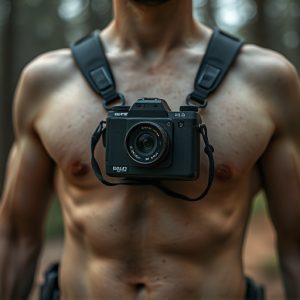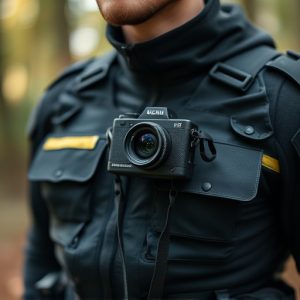Navigating Legalities and Features of Hidden Personal Body Cameras
Hidden personal body cameras have become indispensable tools for law enforcement and private securit…….
Hidden personal body cameras have become indispensable tools for law enforcement and private security, offering discreet high-quality video recording with the added benefit of a built-in flashlight for low-light environments. These devices are designed for practical use, featuring motion activation, an emergency lock for selective recording, and robust construction to handle daily wear and tear. They provide intuitive operation, substantial storage capacity, and secure data transfer capabilities, ensuring users can confidently record significant events and safeguard their well-being. With a range of mounting options, these cameras are a vital addition to personal security technology. They boast advanced features like full HD resolution, wide-dynamic range sensors, and high-intensity LED flashlights, making them versatile for various applications beyond traditional law enforcement, including professional use in demanding environments and personal safety. Users must navigate the legal landscape surrounding their use, ensuring they obtain consent before recording and comply with privacy laws that vary by jurisdiction to respect individuals' privacy rights. These cameras, when used responsibly and in accordance with legal guidelines, are powerful tools for accountability and documentation.
When it comes to personal security and documentation, the role of body cameras has become increasingly significant. This article delves into the realm of hidden personal body cameras—compact, discreet devices that offer users a powerful tool for safety and evidence collection without drawing attention. We’ll explore their stealthy features, technical specifications, and practical applications, ensuring you have a comprehensive understanding of these innovative devices. Additionally, we’ll navigate the legal landscape surrounding their use to provide best practices for integrating hidden personal body cameras into your daily life responsibly.
Unveiling the Stealthy Features of Hidden Personal Body Cameras
In recent years, the role of personal body cameras has become increasingly significant in various fields, from law enforcement to personal security. Hidden personal body cameras, a subset of wearable technology, offer users a discreet means to record their surroundings without drawing attention. These devices are engineered with stealth in mind, featuring compact designs that blend seamlessly with everyday attire. The integration of advanced optical components ensures high-quality video capture, while the inclusion of a flashlight function enhances the versatility of these cameras. This dual functionality not only allows for clear documentation during critical events but also serves as a practical tool in low-light conditions. Users benefit from the enhanced situational awareness that comes with the camera’s ability to switch between recording and providing illumination, all within a device that remains unobtrusive.
The stealthy features of hidden personal body cameras are complemented by their user-friendly interface and robust build quality. These devices are often equipped with motion activation and emergency lock functions, ensuring that footage is captured only when needed. The cameras’ storage capacities are substantial, enabling hours of recording time, which is crucial for capturing extended interactions or events. Additionally, the inclusion of secure data transfer capabilities allows users to confidently share recorded incidents with relevant authorities or for personal review. With an array of mounting options and adaptability to various environments, hidden personal body cameras represent a significant advancement in personal security technology, offering users both peace of mind and a reliable recording tool in one unassuming package.
Technical Specifications and Practical Applications of Body-Worn Cameras
A hidden personal body camera with a flashlight integration represents a sophisticated tool for individuals seeking to capture high-quality footage while maintaining a discreet profile. These devices are engineered with advanced technical specifications that cater to both clarity and covert operation. Typically, they feature full HD recording capabilities, wide-dynamic range sensors to handle various lighting conditions, and built-in high-intensity LED flashlights for illuminating dark environments. The cameras often come with high-resolution displays allowing users to preview or review footage without revealing their purpose. The integration of a rechargeable battery ensures operational longevity, while the compact design allows for easy concealment under clothing or within accessories.
The practical applications of such body-worn cameras are vast and varied. They serve as a reliable means for law enforcement officers to document interactions with the public, offering an additional perspective that can be critical in dispute resolution. For personal security, these devices provide individuals with a way to record potentially threatening situations, acting as a deterrent and a means to gather evidence if needed. Adventurers and professionals working in challenging environments can utilize these cameras to capture their experiences without jeopardizing their equipment or compromising their safety. Additionally, the flashlight feature enhances the device’s functionality by allowing users to navigate in low-light conditions while recording, making it an indispensable tool for both professional and personal use.
Legal Considerations and Best Practices for Body Camera Usage
When integrating a hidden personal body camera into one’s daily routine, it’s crucial to be cognizant of the legal framework governing their use. These devices are powerful tools for documenting interactions and ensuring accountability in various settings. However, privacy laws vary by jurisdiction, so users must familiarize themselves with local regulations to avoid potential legal pitfalls. In some locations, recording individuals without their consent may violate privacy rights, regardless of whether the camera is visible or not. Therefore, best practices dictate obtaining clear consent from all parties involved before initiating recordings. Additionally, users should ensure that the device is used in a manner consistent with the law, respecting reasonable expectations of privacy and complying with any applicable notification requirements. It’s also advisable to review the camera’s capabilities, such as audio recording and night vision features like a flashlight, which can enhance the quality of recordings but may also raise additional legal considerations. By adhering to these best practices and maintaining an understanding of the legal landscape, users can responsibly utilize their hidden personal body cameras to document events accurately while respecting the privacy and rights of others.


